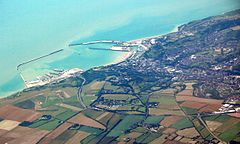| Dover | |
|---|---|
 Aerial view of Dover Harbour | |
Location within Kent | |
| Population | 31,022 (2011 Census)[1] |
| OS grid reference | TR315415 |
| • London | 77.8 miles (125.2 km) |
| Civil parish |
|
| District | |
| Shire county | |
| Region | |
| Country | England |
| Sovereign state | United Kingdom |
| Post town | DOVER |
| Postcode district | CT16, CT17 |
| Dialling code | 01304 |
| Police | Kent |
| Fire | Kent |
| Ambulance | South East Coast |
| UK Parliament | |
| Councillors |
|
Dover (/ˈdoʊvər/ DOH-vər) is a town and major ferry port in Kent, South East England. It faces France across the Strait of Dover, the narrowest part of the English Channel at 33 kilometres (21 mi) from Cap Gris Nez in France. It lies south-east of Canterbury and east of Maidstone. The town is the administrative centre of the Dover District and home of the Port of Dover.
Archaeological finds have revealed that the area has always been a focus for peoples entering and leaving Britain. The name derives from the River Dour that flows through it.
In recent times the town has undergone transformations with a high-speed rail link to London, new retail in town with St James' area opened in 2018, and a revamped promenade and beachfront. This followed in 2019, with a new 500m Pier to the west of the Harbour, and new Marina unveiled as part of a £330m investment in the area. It has also been a point of destination for many illegal migrant crossings.
The Port of Dover provides much of the town's employment, as does tourism including to the landmark White Cliffs of Dover. There were over 368,000 tourists visiting Dover castle in the year of 2019.[3] Dover is classified as a Large-Port Town, due to its large volumes of port traffic and low urban population.[4]
- ^ "Town population 2011". Neighbourhood.statistics.gov.uk. Archived from the original on 7 October 2015. Retrieved 3 October 2015.
- ^ "Dover Town Council". Dovertowncouncil.gov.uk. Archived from the original on 16 October 2017. Retrieved 4 August 2017.
- ^ Neate, Rupert (20 December 2012). "White cliffs of Dover: locals repel buyout by the French". The Guardian. Archived from the original on 1 December 2017. Retrieved 21 November 2017.
- ^ Roberts, Toby; Williams, Ian; Preston, John (2021). "The Southampton system: A new universal standard approach for port-city classification". Maritime Policy & Management. 48 (4): 530–542. doi:10.1080/03088839.2020.1802785. S2CID 225502755.
